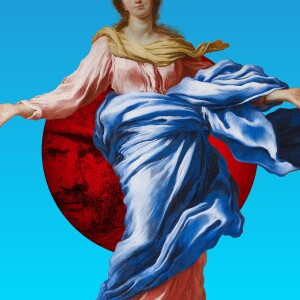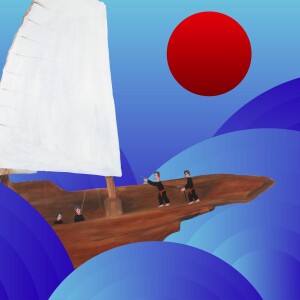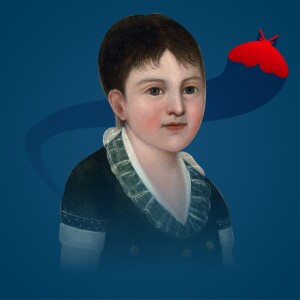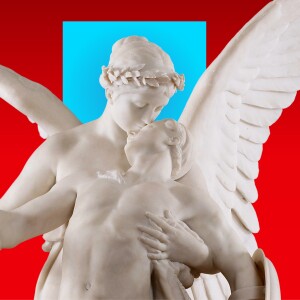Episodes

Monday Dec 19, 2022
Monday Dec 19, 2022
In 1650, a less-than-holy artist is hired to paint a religious mystery even the pope isn't totally sure about. It's just one part of the Church's plan to counter its enemies with guns, inquisitions, and art, but the mystery—and the artist—will become increasingly popular as a new world threatens to end the old.
You can see the grand artwork mentioned in the show here, in the collection of the Minneapolis Institute of Art: https://collections.artsmia.org/art/1613/the-immaculate-conception-with-saints-francis-of-assisi-and-anthony-of-padua-giovanni-benedetto-castiglione

Monday Nov 14, 2022
Monday Nov 14, 2022
In the mid-1960s, Richard Avedon is the most famous photographer in the world, redefining fashion and celebrity while becoming an icon himself. But as America is shaken by the war in Vietnam and racial strife, he struggles to reinvent himself as a serious artist, showing the country as it is—not as it pretends to be.
You can see more than a dozen of Avedon's most famous photographs, including his portrait of Marilyn Monroe and Dovima with elephants, in the collection of the Minneapolis Institute of Art: https://collections.artsmia.org/search/Richard%20Avedon
You can see images of his groundbreaking 1970 show at the Minneapolis Institute of Art here: https://www.avedonfoundation.org/minneapolis-institute-of-arts-mn-1970-richard-avedon
And images of Avedon's very 1960s fashion shoot with Angelica Huston in Ireland here: https://lineargrey.wordpress.com/portfolio/when-anjelica-met-avedon/

Monday Oct 10, 2022
Monday Oct 10, 2022
In ancient China, a royal sorcerer named Xu Fu is sent with some 60 ships to find the elixir of immortality. But on the second voyage, he and his crew of thousands disappear. Possibly to Japan, legend suggests, where Xu Fu becomes the first emperor. Now, as a Hmong artist explains, one clue to their fate may lie with his people’s own legendary history.
You can see the entire 50-painting series of “The Hmong Migration” by Cy Thao, mentioned in this episode, in the collection of the Minneapolis Institute of Art, including the painting depicting Xu Fu’s voyage:
https://collections.artsmia.org/art/89559/5-cy-thao

Monday Sep 12, 2022
Monday Sep 12, 2022
In 1798, a portrait artist named Joshua Johnson advertises himself as a “self-taught genius.” A few decades later, he will nearly be forgotten. It’s a mystery only now being revealed: the unlikely story of the man sometimes called America’s first Black professional artist. A story of slavery and freedom, racism and redemption, nearly lost to history.
You can see Johnson's "Portrait of Richard John ," c. 1817, here in the collection of the Minneapolis Institute of Art: https://collections.artsmia.org/art/106096/portrait-of-richard-john-joshua-johnson

Monday Aug 08, 2022
Monday Aug 08, 2022
As long as people have told stories, we have told stories about animals. Stories of slow turtles and fast rabbits, sly foxes and cunning monkeys, that are really stories about ourselves. But why? What can animals tell us about human nature? And what happens to our fellow creatures when we turn them—in art and literature and myth—into something they’re not?
You can see Edwin Landseer’s startling painting of the 17th century fable “The Monkey and the Cat” in the collection of the Minneapolis Institute of Art (just don’t show your cat):
https://collections.artsmia.org/art/3077/the-cats-paw-sir-edwin-henry-landseer

Monday Jul 11, 2022
Monday Jul 11, 2022
Leonora Carrington has never felt at home in her wealthy, conservative family. But when she meets the Surrealists in the 1930s, and runs from everything she knows, it will take everything she has to become the artist and writer she wants to be. Most importantly: her singular imagination, which reveals the world as both more magical and more haunted than most of us care to admit.
You can see her feminist take on Surrealism in this painting from the collection of the Minneapolis Institute of Art: https://collections.artsmia.org/art/98514/dear-diary-never-since-we-left-prague-leonora-carrington

Monday Jun 06, 2022
Monday Jun 06, 2022
No one lives forever. But that hasn’t stopped people from trying, and for a long time the noble way to avoid getting old and dying was to avoid getting old at all: the Greek notion of the “glorious death” that confers immortality in battle. It’s an idea that resurfaces throughout history—until it meets its match in a war of many deaths and little glory.
You can see “Kiss of Victory,” the sculpture that kicks off this episode and launched the career of Sir Alfred Gilbert, in the collection of the Minneapolis Institute of Art: https://collections.artsmia.org/art/2279/kiss-of-victory-sir-alfred-gilbert

Monday May 09, 2022
Monday May 09, 2022
The man behind "The Three Musketeers" and "The Count of Monte Cristo" was one of the richest, most popular authors in the world—an adventurous celebrity who could fight as well as write. But many of Alexandre Dumas’ readers today don’t know that he was Black—or that his best story may have been his own.
A portrait of Alexandre Dumas, widely reproduced in his day, was recently acquired by the Minneapolis Institute of Art:
https://collections.artsmia.org/art/142671/portrait-of-alexandre-dumas-pere-pierre-francois-eugene-giraud
Another portrait of Dumas in Mia’s collection—younger, dashing, looking a little like Prince: https://collections.artsmia.org/art/54426/portrait-of-alexander-dumas-achille-deveria

Monday Apr 11, 2022
Monday Apr 11, 2022
In the 1970s, Georgia O’Keeffe is supposedly the hermit savant of the New Mexico badlands, rarely heard and seldom seen, even as the outside world can’t get enough of her enigmatic art. But when curators, journalists, and even the FBI come calling, it seems the head ghost of Ghost Ranch is the host with the most—and hardly ever alone. A fresh look at a myth we can’t stop believing.
You can see one of O'Keeffe's badlands pictures, "Black Place I," in the collection of the Minneapolis Institute of Arts: https://collections.artsmia.org/art/119128/black-place-i-georgia-okeeffe
Also, one of her iconic views from Ghost Ranch, "Pedernal--From the Ranch #1": https://collections.artsmia.org/art/1554/pedernal-from-the-ranch-1-georgia-okeeffe
And a photograph of her with husband Alfred Stieglitz: https://collections.artsmia.org/art/1973/stieglitz-and-okeeffe-arnold-newman

Monday Mar 14, 2022
Monday Mar 14, 2022
(Season 4 premiere) It’s one of the largest jade sculptures in the world, a 640-pound mountain commissioned by the Chinese emperor. But in 1901, in the ugly aftermath of the Boxer Rebellion, it ends up leaving China with an American diplomat—only to resurface on the dinner table of a lumber baron. It’s a story of power and scandal, a story as old as stone: can anyone be king of the hill for long?
You can see "Jade Mountain Illustrating the Gathering of Scholars at the Lanting Pavilion" here: https://collections.artsmia.org/art/4324/jade-mountain-illustrating-the-gathering-of-scholars-at-the-lanting-pavilion-china
